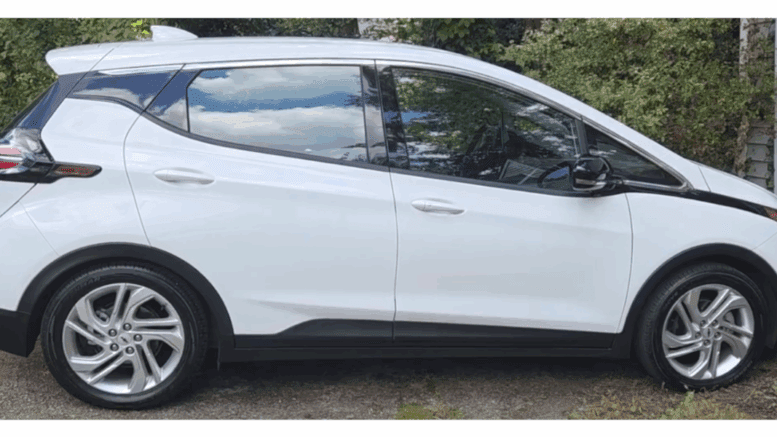By Larry Felton Johnson
As part of a project to convert to electricity as much as possible, I purchased a used 2023 Chevy Bolt 1LT EV (electric vehicle) three days ago, and I’m already in love with it.
I’m sure that I’ll discover things I don’t like about it as the honeymoon period wears off, and I’ll let you know about those downsides as I find them, but for now, it’s been all upsides.
Here’s a short video I posted on Facebook when the Bolt arrived:
I spent the first full day learning the necessary basics quickly (how to open the doors, start the car, charge the car at home, charge the car at a public charging station, turn on the windshield wipers and headlights, etc.).
My approach now is to tackle one major aspect of operating and maintaining the car at a time.
This series will present what I learn as I do this, starting with one-pedal driving.
One-pedal driving
I tried one-pedal driving yesterday and used the car to run about 20 miles’ worth of errands I’d accumulated. It was a great deal of fun, and I only used the friction brakes once during the trip (a tanker truck abruptly stopped in front of me, and I didn’t trust my speed + one-pedal stopping distance).
One-pedal driving is just what it sounds like. You start moving by depressing the accelerator pedal, and stop by lifting your foot. By default, the car slows to a stop within a reasonable distance based on the speed you are going.
You do have a brake pedal for emergency stops, but I only used it once, for the purpose I mentioned above.
One-pedal driving does take some practice, but not much. I already had some experience with one-pedal driving when I wrote about the Polestar dealership in Battery Atlanta, and the owner of the dealership let me test drive. It took me about five minutes driving around the Cumberland area to become comfortable with ignoring the separate brake pedal, and I already loved it.
My Chevy Bolt had a similar learning curve. I pressed the button that put the auto in one-pedal mode, and started up Oakdale Road and Highland Parkway toward the East-West Connector. By the time I reached the connector, I was barely aware I had a separate friction brake.
There are two technical advantages of one-pedal braking.
It creates a lot less wear and tear on the car. If you don’t use the friction brakes, there is no wear on the brake pads.
But the second advantage is even more interesting. One-pedal driving utilizes regenerative braking, where some of the energy expended in stopping the car is converted back into electricity and stored in the battery, thereby prolonging the charge.
In slightly more detail:
In electric (or hybrid) vehicles, when you slow down, the electric motor reverses roles and acts like a generator. Instead of using friction to stop, the wheels spin the motor in reverse. This reversed spinning generates electricity, which is stored in the battery for later use.
There are always trade-offs
I don’t consider EVs the solution to the history of bad zoning decisions in the U.S. We drive far too much, and our built landscape and transportation policies not only enable that, but in many ways make it necessary.
However, EVs fit nicely into a general hierarchy I’ve developed over my life.
First, it’s better to walk if I can. It’s better for my health, and better for the environment. I was lucky enough to grow up in a time and place where everything I needed was within walking distance (Grant Park in the 1950s and 60s).
A grocery store, barber shop, and pharmacy were on the corner about 100 feet from our front door. My elementary school was three short “city blocks” from our house, and our high school was about five blocks. Our church was across the street from the grocery store I mentioned. Grant Park at that time had a swimming pool, a lake, pavilions, and sports fields. And the park was two short blocks from our house.
Less than three miles away was East Atlanta, at the time a fully functioning business district with two banks, two pharmacies, a movie theater, a public library, a record store, a hobby shop, two supermarkets (smaller than today’s versions, but certainly adequate), a sporting goods/military surplus store, a hardware store, and a post office.
This isn’t just nostalgia on my part. It’s a sign of better urban design, developed in a time when communities were not built around the automobile.
The second part of my hierarchy is to cycle when I can. This extends my realistic errand range by a few miles.
With all that said, I have to navigate a county with wretched public transportation and pedestrian and cycling infrastructure that’s often downright dangerous. So a car is a necessity for me.
Electricity can be produced in a manner that causes significantly less environmental damage than other means of producing energy. Fossil fuels offer limited opportunities for reduced emissions and are, by definition, non-renewable.
Electricity isn’t always produced in the most environmentally friendly way, but with modern solar and battery storage technology, it has a potentially much lower carbon footprint and is renewable (a quality that can’t be claimed by any fossil fuel).
So, all things considered, I’m happy with my EV, both in terms of the satisfaction that I’m polluting less than I would with an internal combustion engine and that it’s fun to drive.
Bonus video, an 88-year-old man describes his EV experience
As I obsessively watched videos about the Chevy Bolt, I ran across this gem. It made me feel better about starting my own EV experience at 74 years old.
